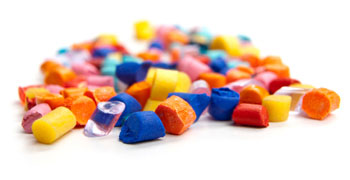
The selection of the coloring technique is dependent on two factors and each must be considered before a decision is made. These factors are:
- Quality of color distribution
- Quantity of color required
Quality
Approximately 75 per cent of color distribution requirements can be satisfied by dry coloring. Limitations deal with the blow-molding equipment and its ability to disperse color, and with the total level of pigment required for the end use. Short-barrel extruders with low compression ratios, nonmetering screws, short land length dies or extremely high output rates can cause inadequate distribution of even low levels of dry color pigments and yield a product that is color-streaked. Pigment level is also a necessary control, since specific applications may require in excess of 2% per cent pigment. This pigment level is difficult to obtain by dry color methods in any machine and the use of compounded color is usually required to obtain good distribution. High pigment concentration is used to obtain proper opacity in thin sections or protection of product in certain containers from light. In special packaging applications high pigment content is used as a means of protecting the package from discoloration and staining by the product. Many items can be successfully packaged in polyethylene only if a sufficient pigment level is used to prevent staining. A typical example is a dark dye that will gradually discolor polyethylene due to absorption. The higher the content of a pigment, such as titanium dioxide, the longer it will take to show discoloration of the container. This phenomenon can also be used in containers to reduce permeability in difficult-to-package products where a material such as polyethylene is borderline in the natural color state.
Color can produce adverse effects on blow-molded parts. Physical properties such as impact strength and stress-crack resistance can be reduced and surface characteristics of the part can be altered. Tests on blow molded products will show reduced impact and possible surface dullness with high pigment level, such as 2/2 per cent or above. If an application calls for this concentration of color it will be advisable to conduct end use tests on the final production parts. Pigment concentrations in the range of % per cent to 1% per cent will usually have only minor effect on properties.
Quantity
The purchase price of thermoplastic resins depends on quantity of material and therefore the ability to color small lots in plant is advantageous. Where small color quantities are required, the dry color process is optimum. In addition the molder does not face the problems associated with inventory of molding materials in a variety of colors. Long production of blow molded products manufacturers runs of a single color will also be most economical by dry coloring rather than by compounded color if color quality is satisfactory.
